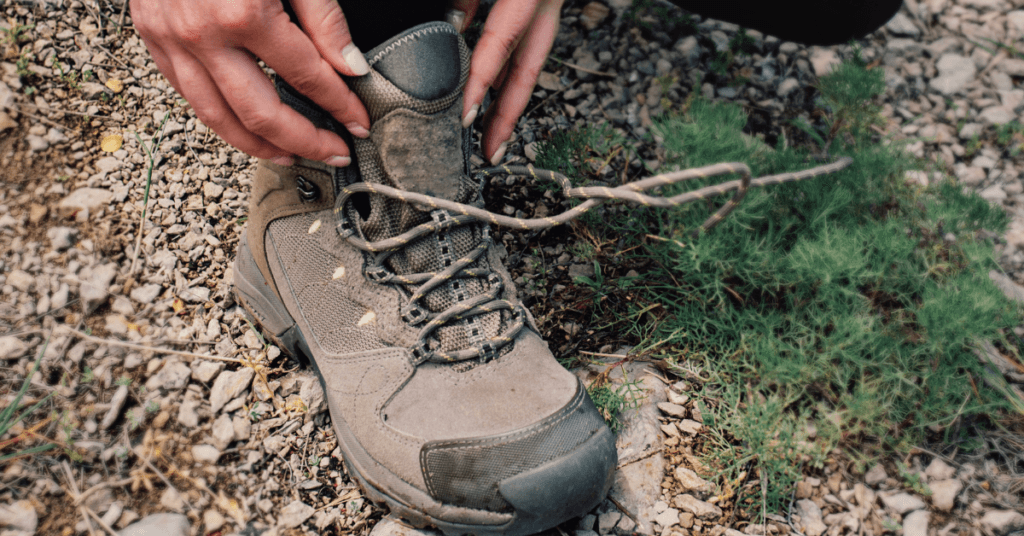Specific shoes for walking have cushioning to keep your feet pain-free, but can you run in walking shoes? The answer is no, and you should not.
Walking and running in the great outdoors is the physical activity of choice for many, but wearing the proper shoes is key to keeping exercise pain-free.
When walking or hiking, you may break into a sprint or jog to get up an incline, and you may have wondered, “Can you run in walking shoes?” Nevertheless, the cushion design for walking and running shoes is different, and you will likely injure yourself. Let’s look at this in detail.
Contents
Walking Shoes
Good walking shoes can come in several guises. If you’ve been to the East Coast or Europe in winter, you’ve probably seen a stubborn Californian wearing a boat shoe as their walking shoe. You may have rolled your eyes because you knew their feet would freeze and their knees would also hurt later.
If you live in these environments, you know good boots are the best choice to keep your feet warm and comfortable without destroying your knees or ankles.
But if you live in the southern US or other hotter environments, you’ve likely also seen someone similar wearing boots in high summer and wondered just how on earth that could be comfortable.
The shoe you choose depends on both your environment and your purpose for walking. If you’re only planning on bringing one pair of shoes for your vacation, you may ask, “can you run in walking shoes?” to save on packing space.
Can You Run in Walking Shoes? The Short Answer
The short answer is no, and you should not run in shoes specifically designed for walking. You can walk in running shoes, but not the other way. We know you already know you should not run in boots or vans because they do provide adequate support or cushioning. New fitness walking shoes may look like they give support, but their cushioning is designed differently – so you should leave the job of helping you run.
Check out our explainer on can you run in bike shorts.
Can You Run in Walking Shoes – The Long Answer

For those wondering why you should not run in walking shoes, the reasons mainly relate to the placement of cushioning and the actual foot movement of walkers and runners.
What Both Shoes Need
Both shoes for fitness running and walking must share non-negotiable characteristics. If on a long day trip out in the cold, boots or other thicker shoes should serve you well. But for fitness, studies show both need to be flexible and bend to adjust to your activity level. Both shoes must fit snugly on your foot to avoid sliding or moving.
While slight slides may sound harmless, they can build up uncomfortable blisters and damage your toes.
Cushioning for Walking Shoes
Unless you’re Frankenstein’s monster, walking steps tend to hit the ground with less impact than running. Walking shoe design keeps the sport of walking in mind, with the cushioning concentrated at the heel. Walking shoes are often lighter, allowing you to keep going rather than lifting the weight of a heavier shoe repeatedly.
Cushioning for Running Shoes
Speed and bounce increase the impact runners make on the ground with each stride. Consequently, their shoes must absorb or repel the shock to prevent shin splints or knee pain. Running shoes have a concentration of cushioning around both the forefoot and heel, keeping runners going without serious pain or damage to their feet and legs.
Step Pattern for Walking Shoes
Walking steps start at the heel and end in a push from the ball of the foot. This step pattern means that walking shoes or shoes suitable for walking have good heel cushioning or flat bottoms to keep steps comfortable and facilitate an easy, sustainable step pattern.
Walking shoes will also not have heel flares, which add extra stability for running, but can get in the way of the actual stepping pattern for walking.
If you choose to pick a pair of running shoes for fitness walking, avoid a pair of shoes with heel flare or forefront cushioning.
Step Pattern for Running Shoes

Running’s step or “strike” pattern is less uniform than walking. Each runner usually insists a different “strike” pattern is superior to others because there are different runners – sprinters, casual runners, marathoners, and then ultra-marathons. The running shoe type should differ according to your strike pattern.
For toe strikers, such as sprinters and fitness speed demons, quality cushioning on the ball of the foot is crucial and will spare you pain in your feet or knees so that you can instead focus on the pain in your lungs as you speed through your run.
Heel and midfoot strikers, our distance-oriented friends, need more stability in their heel cushioning, such as a heel flare, to keep them moving correctly and might need a higher heel-to-toe drop to speed up their steps.
No matter what you choose for your running or walking shoes, you should ensure they work for your feet, pace, style, and fitness goals.
Ever wondered is running better than walking? Read our article to find out. And just in case you were wondering, “can you run in hiking shoes?” we have got that covered too!



